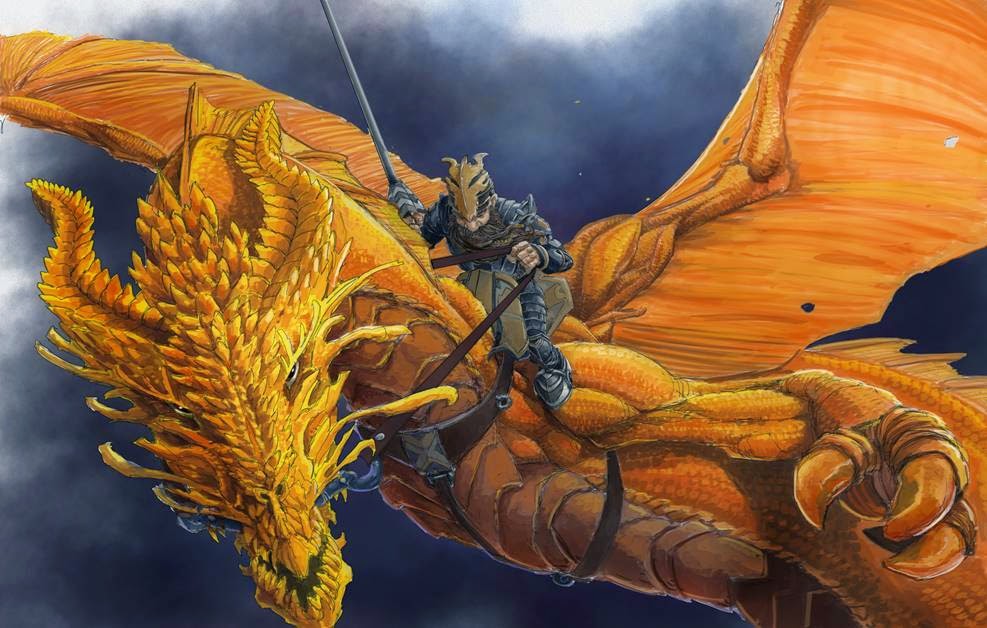13th Age in Glorantha will contain around twelve chapters. That’s too much to summarize in a single blog post, so this tour of the work-in-progress book starts with the first chapter: Initiations.
As an opening chapter, Initiations introduces newcomers to Glorantha while unveiling several mechanics we’re creating to handle new styles of 13th Age adventures.
As part of Initiations, you’ll find. . . . .
. . . .a short introduction to Glorantha and its gods and runes. Runes aren't like the temporary magic items in the 13th Age core rulebook. Gloranthan runes are symbols that hold true cosmic power. They're the building blocks of reality, and sometimes also the weapons that can destroy pieces of reality you don't like. For example, the war god Humakt is the original wielder of the Death rune. . . and it’s shaped like a sword! Humakt is also the sworn enemy of things that break the laws of death, namely the undead. Humakt’s runes are Death and Truth, but he’s not the only god associated with these runes. Thanks to stretch goals, our book will also include the crazy-berserk troll god of Death and war, Zorak Zoran, who is the dishonorable opposite of Humakt who even offers necromancer-style secrets of creating undead!

The Initiation’s chapter’s short overview of the world’s mythology has links pointing to all the other full myths that will be appearing later in the book. It will be what newcomers need as an introduction to the world, enough to get them rolling through the myths and dangerous locations later in the book. For those who want more, there will be more information in the Glorantha Source Book that’s also being created as part of the Kickstarter.
. . . .the basics of the cosmological battle against Chaos, as well as notes on our game’s default setting, a catastrophic moment of Unraveling when Time’s web breaks and Chaos crashes in. The purpose of setting our action during a Chaos-eruption is that newcomers to Glorantha can feel free to play in the world without feeling like they need to understand all its previous details. Long-time fans of Glorantha can do as they like, newcomers can operate in the less-structured setting of the Unraveling.
. . . . introduction of the system that’s taking the place of the icon relationships in the core 13th Age rulebook. The system appears to have two parts, worship and rune affiliation. Although the system is phrased as ‘worship’ in Glorantha it could easily be used in 13th Age games played in the Dragon Empire or any campaign world with icons. I’m excited about this revision of our freeform storytelling mechanics. We’ve started over, searching for what we most want to use for Glorantha-style games instead of just translating our existing mechanics.
. . . . an introduction to the way we’re handling playable myths. Take a Gloranthan myth, like the story of The Suitors, in which various gods seek to impress Ernalda. Tell the myth, paragraph by paragraph, in standard mythic prose. Wherever the myth demands, write-up a station of the heroquest that a worshipper (and friends) would experience when they cross to the Godtime and adventure within that myth. Myth stations end up something like rooms in a dungeon. What kind of dungeon? Not the logical real-world type! The mythic anything-can-happen & there’s always a heroquest surprise type of dungeon! The type of dungeon where Chaos is actively corrupting pieces of the myth you used to be able to count on, so that one of the suitors for Ernalda’s hand turns out to be an albino demon-Broo wielding a dragon-sword stolen from a heroquest the player characters fumbled earlier in their careers! On the bright side, death while you are heroquesting isn’t necessarily fatal, like death in the actual world—it just creates dangerous obligations, surprising weaknesses, or the type of plot complication/campaign loss that epics get built around . . . if you survive!
It’s worth mentioning that 13G campaigns will generally alternate between adventures taking place on the map and adventures played out in the Godtime of heroquesting. In a sense, the GM is encouraged to set up the war against Chaos (or the Lunars, or whoever the current enemies are) as a two-front battle, fought both in the mortal world and in the Godtime.
It’s also worth noting that low level player characters don’t delve all the way into the deep Godtime when they heroquest. They’re more likely to go on local heroquests, trying to chase the undead out of a particular set of valleys via magic (instead of hunting every last one down in person!), or restoring a desecrated shrine to the ancestors by returning to the moment the clan hero created the shrine, or recovering a specific war banner from a long-lost hill fort. Many of these low level heroquests will show up in the geography chapter that appears toward the end of the book.
At champion and epic tier, the heroes become more likely to survive serious myth-crawling, quests that intersect with the stories of the gods themselves instead the god’s children or followers. We’ll start seeing some of those serious cosmological myths when we get into the second chapter: Orlanth is Storm King.
















